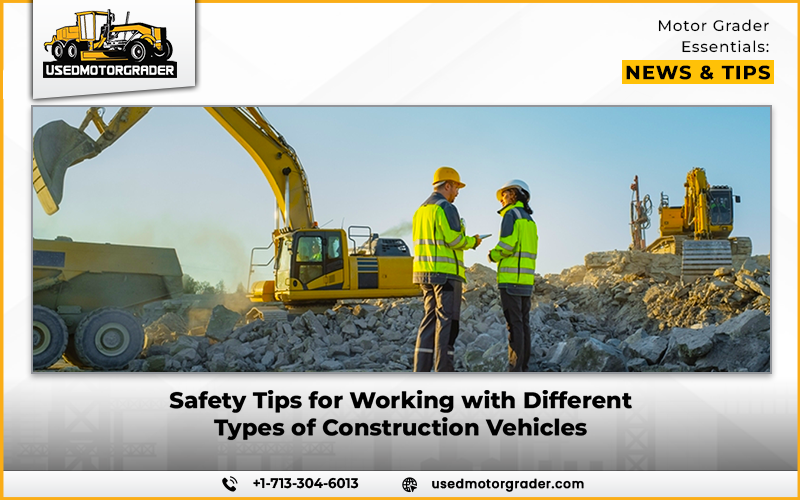Heavy construction equipment is the most powerful yet dangerous thing on construction sites. Without a doubt, in today’s world, the process of construction is nearly unimaginable without using heavy equipment. These are the pivotal parts to make any building, skyscraper, road, or construction project. Nonetheless, the risks these machines possess are also concerning. The size of these machines, along with their weight and the complications of operating them in various fields, makes them dangerous if not handled with care. Different types of construction vehicle accidents can lead to serious injuries, severe damage to the machine, and sometimes the demise of the operator or other field worker.
Therefore, it is crucial to understand and strictly follow safety rules. Because of the consequences, safety should always be the first priority when operating an excavator, bulldozer, or crane. In this blog, we’ll explore important safety tips for working with different types of construction vehicles, helping operators and workers stay safe on the job site.
Why Safety Matters When Operating Construction Vehicles
Construction equipment is used for heavy work and heavy loads, but along with power and size, they carry risks. Hazards often associated with them are rollover, collision, machine failure, and accidents against other workers working nearby. Not only do they risk the life of this equipment operator, but also the life of another worker in the process.
These hazards can be avoided by adherence to proper safety procedures. Watch out and make sure everybody on the job site is qualified and knowledgeable regarding possible hazards. Safety is not merely about your own protection and safety. It is about providing a safe environment for all parties contributing to the job. While a hundred percent elimination of accidents is not feasible at the site, with sufficient care, we are able to mitigate the human factor. This lowers the accident rates with different types of construction vehicles at sites.
General Safety Tips Construction Vehicles
Safety tips applicable to all types of construction vehicles need to be discussed before studying individual equipment. Security procedures establish basic safety procedures which need permanent attention. Operating construction vehicles must be limited to those who completed proper training together with certification. The safe operation requires complete knowledge of the machine controls in addition to its capabilities and operational restrictions.
- Pre-operation Inspection: Vehicle inspection must always happen before using the equipment. Both fluid leaks alongside worn tire conditions and light defects as well as alarm failures should receive inspection.
- Personal Protective Equipment (PPE): Protective gear that includes hard hats along with safety glasses and gloves and steel-toed boots should be worn to avoid injuries.
- Follow Guidelines: You should follow every direction provided by the manufacturer when running their equipment when you operate it within the defined weight thresholds. The improper use of equipment during overloaded conditions will result in accidents.
- Ensure Safe Work Area: Maintain constant attention for workers while checking for obstacles as well as other moving vehicles throughout the site when working.
- Safety Gadgets: Wearing seatbelts remains essential during operations of all type construction vehicles which benefit from built-in seatbelts or rollover protection systems (ROPS). Fasten your seatbelt to stay protected during either a rollover accident or collision.
Other Safety Precautions for Construction Sites
Besides car-specific safety advice, there are some overall safety precautions that need to be taken on the construction site. This is essential both on-site and off-site of the construction project. These habits will create a safe working environment for all parties involved.
- Establish Clear Communication: Employ hand signals, radios, or other communication equipment to keep operators and workers in harmony at all times.
- Mark Hazard Zones: Evidently indicate sections where construction equipment is working in order to maintain a safe distance for workers.
- Implement Traffic Control Plans: For multi-vehicle sites, develop a traffic control plan to avoid accidents and facilitate smooth movement.
- Provide Regular Training: Hold periodic safety training for workers and operators to reiterate best practices and mitigate new hazards.
- Encourage Reporting: Develop an environment in which employees are at ease reporting safety issues or near-misses without the threat of reprisal.
To Sum Up
The use of construction vehicles involves the use of equipment, skills, attitude. And bearing in mind different safety precautions that are sufficiently necessary to follow. From the above-discussed points, employers and employees should be able to enhance safety on jobsites. Also, minimize the chances of accidents happening. It is imperative to remember that safety is orientation and not just a responsibility. If you want to use an excavator, bulldozer, crane, forklift or any other heavy and enormous equipment. Ensure that you exercise a lot of caution in order to avoid danger. Both to yourself and to other people.


